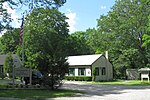Manorville station
1844 establishments in New York (state)1968 disestablishments in New York (state)Brookhaven, New YorkFormer Long Island Rail Road stations in Suffolk County, New YorkNew York (state) railway station stubs ... and 2 more
Railway stations in the United States closed in 1968Railway stations in the United States opened in 1844

Manorville was a railroad station on the Main Line of the Long Island Rail Road in Manorville, New York. The station was built in 1844 and closed in 1968.
Excerpt from the Wikipedia article Manorville station (License: CC BY-SA 3.0, Authors, Images).Manorville station
Ryerson Avenue,
Geographical coordinates (GPS) Address Nearby Places Show on map
Geographical coordinates (GPS)
| Latitude | Longitude |
|---|---|
| N 40.874819 ° | E -72.808338 ° |
Address
The Maples
Ryerson Avenue 10
11949
New York, United States
Open on Google Maps





